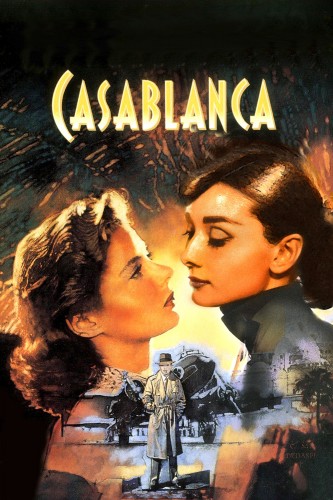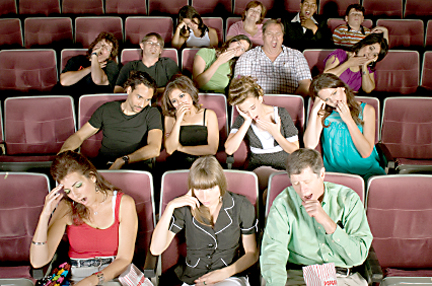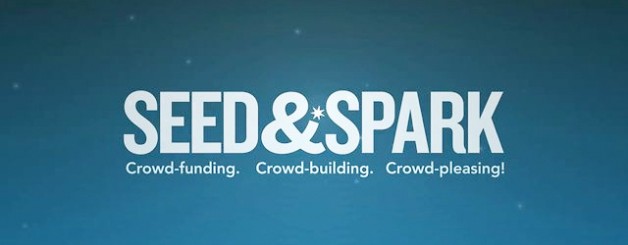
This is a guest post by Allie Esslinger.
I grew up at the knee of amazing storytellers; talk was cheap and all we could afford. There was never a nest egg, but I always had a cache of stories…and I had television. And…I watched a lot of it. Malcolm Gladwell theorizes a person needs 10,000 contact hours to be brilliant in any one area: serialized, episodic content is my only shot.
I should also mention that I was raised in Alabama — home of the Crimson Tide, Rick Bragg, and the only ABC affiliate that did not air Ellen’s coming out episode in 1997. It took me a long time to understand myself in the context of the world at large because I didn’t have much access to it. A lot of progress has been made, but there’s still a lot to be done.
The idea that I made it through thousands of hours of programming and 20 years of life before I ever saw another mixed race lesbian is astonishing. There are 200+ LGBTQ film festivals each year, but only 17 films with a queer female character made it to theaters in 2012. If you aren’t lucky enough to get to OutFest or Gaze or Frameline, it can take months or even years to find a film that got buzz when it premiered– and especially ones that didn’t.
Last month I was finally able to see the full short film Social Butterfly, which was at both Sundance and SXSW in 2013. It stars Anna Margaret Hollyman and was writtern and directed by Lauren Wolkstein, one of Filmmaker Magazine’s Top 25 to Watch, among other accolades. It’s a different circumstance — the film was bought at the festival and is currently playing on television in France — but there are so many films that go undistributed out of festivals and then aren’t available again unless the filmmaker themselves are willing to promote, distribute, and make us all aware of their film rather than start a new project.
Despite my love for the gang on Friends, my affinity for high schoolers on the CW, and my complete and utter sympathy for every doctor to ever time an inner monologue to a catchy indie rock tune, I never felt like I had a character who I could identify with on a personal level. Although I generally agree that the beauty of the best films and series is that their stories transcend their characters and their settings, I also maintain that sometimes it’s nice to have the film do the leg work. I don’t always want to be metaphorically related to the person I’m watching on screen. I want it to be obvious (like this new campaign we started on our Tumblr that will re-imagine classic romances as lesbian romance films through their key poster art). It’s not just that the lack of well-produced, well-developed lesbian stories has a negative effect on queer women — it hurts society to never see diverse depictions of this diverse segment of the population. And that’s something we can fix.
When I was a sophomore in college, I walked into an Honors seminar with a blank index card waiting for me as I sat down. On one side, Dr. McKenzie had us write the most important question we could ask ourselves, and on the other side, we wrote the one thing the world needs most. Before he read the answers aloud, he explained that the exercise is the foundation for politics–the work of connecting the self with the needs of others. Since we only had 30 seconds to think of these answers, I learned in less than a minute what is most important to me as an individual and a world citizen.
What does the world need most?
Hope.
What’s the most important question I can ask myself?
Am I being helpful?
That index card was like a globe spinning on its axis, and then all of a sudden, it was laid out flat like a roadmap–self-awareness and optimism as the compass.
Although I don’t share a common background with many people that I meet, I can relate to them thanks to my shared vocabulary: the lexicon of water-cooler moments provided by Bright/Kaufman/Crane, Angelou, Sorkin, Kaling, Chaiken, Fey, and so many others–and I will always be grateful for that. Entertainment and popular culture are universal languages that anyone can buy into as long as she’s willing: social capital as accessible as cable (and the Internet). That the same 35 lesbian-related films are available to stream on Netflix, Hulu, and Amazon Prime–which is only about 20 percent of the overall “Gay and Lesbian” Genre tag–is frustrating because we’ve made so much progress offline. The fact that there are fewer than 200 films total that we can rent, stream, and buy on major platforms is discouraging, but it doesn’t mean that’s how it has to be forever.
Until 1968, “Section II” of the Motion Picture Production Code outlawed lesbian characters in film. I am reclaiming our namesake as the premier space for relevant content and the people who love it. We want to help deliver diverse content with strong minority characters in major roles so that more people are included in–and compelled to be a part of–more water cooler moments.
Section II is a new Benefit Corporation dedicated to improving the representation of queer women in popular culture. Even in 2013, part of that equation remains “visibility,” but I’m also talking about divergent stories, different formats, contemporary issues being presented without making “issue films.” We’re building a destination platform for curated, high-quality, lesbian-related films and series committed to the idea that seeing positive portrayals of people we identify with is good for us and good for the people who love us. We’re a new option for both filmmakers and audiences alike — a place for all the best content. The model for releasing a film is changing, but I don’t think that should worry filmmakers. Knowing where a film can live takes away the pressure to modify a film’s premise in order to find an audience. Of those 17 films with a theatrical release, Pitch Perfect was the only one was from a major studio that GLAAD deemed a positive portrayal based on their Vito Russo Test. You won’t find a bigger Pitch Perfect fan than me, but after years of looking for queer women in film, 1 positive portrayal out of 101 studio films remains disheartening.
Last year I produced a sizzle reel for a film that is currently looking for funding, called Pretty Girls. It will be a second feature for the talented team at Invisible College, Andrew Gitomer and Jonathan Stromberg. My plan for last summer was to follow suit and produce three trailers for films that I wrote or co-wrote, all of which would fit nicely (I’m biased) on Section II. Last Spring I was in the throes of pre-production and creating comps and worrying about finding investors for the slate of films when the idea for the platform emerged. And then the opportunity to develop it was presented through the Dogfish Accelerator, a program designed to make filmmakers think more like start-ups and give themselves better odds for longevity. It’s been a long sprint as we work to test and plot-out enough of this idea to pitch to investors next month, and it’s been invaluable to have the chance to talk with film lovers, filmmakers, and distributors to make sure we’re creating an ecosystem that will sustain all the different segments who want to see an increase in quantity and quality of lesbian-related films.
I was so excited to have the chance to write a post for Bitch Flicks because it’s a site that has taken matters into its own hands–it addresses a void by building a community around conversations that want to take place. It’s what we want to do at Section II.
I considered writing a fan letter about Ingrid Jungermann’s post-gay agenda and Julie Goldman’s irreverently endearing brand of stand-up comedy. I could write about how I geeked out when Lauren Wolkstein accepted my Facebook friend request or when I finally had a good reason to introduce myself to Lena Waithe. I could’ve recycled my analogies about how Brooklyn is like Paris of the 20s because everyone is doing cool things that spur me to figure out the anatomy of a platform launch. But I realized that Section II is a fan letter, and that what I’m most excited about is this process of delivering it to everyone else who is excited about the direction lesbian-related films and series are heading.
We launch this month with a showcase site designed to show you that we’re serious about outstanding content and the talent behind it. I hope you’ll join in on the fun.
[youtube_sc url=”http://www.youtube.com/watch?v=jMYG8yD9lqQ”]

Allie Esslinger is a Southern transplant living in Brooklyn. Her company, Olive Juice Films, has produced projects across genres, including documentaries, feature films, web series, live comedy, and commercial campaigns. She earned her BA in International Affairs at the University of Alabama, her MA in International Affairs and Media Studies from The New School, andher MFA in Creative Writing (Screenwriting) from Full Sail University. She is developing Section II, an online and streaming platform for curated, high-quality lesbian content.
























































